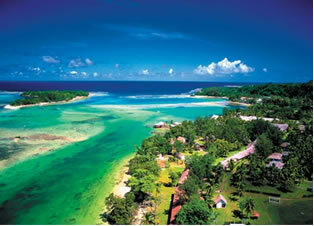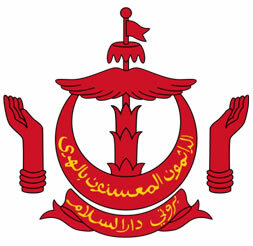Located in Oceania, in the region called Melanesia, the territory of Vanuatu is formed by 83 islands that occupy the New Hebrides archipelago. The country has no land borders, and the closest nations are the Solomon Islands (to the north) and Fiji (to the east). Situated in a convergence zone between tectonic plates, Vanuatu is frequently hit by eruptions, tremors and tsunamis.
In 1887, the French and British began the colonization of the New Hebrides archipelago, which gained independence in 1980, adopting the current nomenclature – Vanuatu. Since then, the country has joined the British Commonwealth: a bloc formed by the United Kingdom and its former colonies. The legacies of the colonization process are present in the country's official languages: English, French and Bislama, which is a regional adaptation of English. In addition to these three official languages, there are another 100 tribal dialects.

Coat of arms
Tourism and financial services are the most responsible for raising revenue in the country. However, agriculture, especially subsistence, employs the majority of the population. Another prominent economic activity is fishing.
Despite having some socioeconomic problems, the inhabitants of Vanuatu are considered the happiest on the planet. This finding occurred in 2006, when a Non-Governmental Organization (NGO) from the United Kingdom surveyed the level of happiness of the population of 178 countries, and the Vanuatuans led the ranking. One of the main reasons for this achievement is the natural beauty that the country is home to.
Do not stop now... There's more after the advertising ;)

Vanuatu
Vanuatu Data:
Territorial extension: 12,189 km².
Location: Oceania.
Capital: Porto-Vila.
Climate: Equatorial.
Government: Parliamentary Republic.
Administrative division: 6 provinces.
Languages: Bislama, French, English (official), regional languages.
Religions: Christianity 92.8% (Protestants 51.6%, Anglicans 17.1%, Catholics 14.4%, others 9.7%), traditional beliefs 3.5%, others 3.1%, no religion and atheism 0.6%.
Population: 239,788 inhabitants. (Men: 122,288; Women: 117,500).
Composition: Nivanuatus 92%, other Micronesian groups 6%, Southern Europeans 2%.
Demographic density: 19.6 inhab/km².
Average annual population growth rate: 2.5%.
Population residing in urban areas: 25.11%.
Population residing in rural areas: 74.89%.
Life expectancy at birth: 69.6 years.
Currency: Vatu.
Gross Domestic Product (GDP): $574 million.
GDP per capita: 1,995 dollars.
External relations: World Bank, Commonwealth, IMF, UN.
By Wagner de Cerqueira and Francisco
Graduated in Geography
Brazil School Team
countries - geography - Brazil School
Would you like to reference this text in a school or academic work? Look:
FRANCISCO, Wagner de Cerqueira and. "Vanuatu"; Brazil School. Available in: https://brasilescola.uol.com.br/geografia/vanuatu.htm. Accessed on June 28, 2021.



